Clément Moulin-Frier
Flowers
Complex System Exploration with Interactive Human Guidance
Oct 01, 2025Abstract:The diversity of patterns that emerge from complex systems motivates their use for scientific or artistic purposes. When exploring these systems, the challenges faced are the size of the parameter space and the strongly non-linear mapping between parameters and emerging patterns. In addition, artists and scientists who explore complex systems do so with an expectation of particular patterns. Taking these expectations into account adds a new set of challenges, which the exploration process must address. We provide design choices and their implementation to address these challenges; enabling the maximization of the diversity of patterns discovered in the user's region of interest -- which we call the constrained diversity -- in a sample-efficient manner. The region of interest is expressed in the form of explicit constraints. These constraints are formulated by the user in a system-agnostic way, and their addition enables interactive system exploration leading to constrained diversity, while maintaining global diversity.
Expedition & Expansion: Leveraging Semantic Representations for Goal-Directed Exploration in Continuous Cellular Automata
Sep 04, 2025Abstract:Discovering diverse visual patterns in continuous cellular automata (CA) is challenging due to the vastness and redundancy of high-dimensional behavioral spaces. Traditional exploration methods like Novelty Search (NS) expand locally by mutating known novel solutions but often plateau when local novelty is exhausted, failing to reach distant, unexplored regions. We introduce Expedition and Expansion (E&E), a hybrid strategy where exploration alternates between local novelty-driven expansions and goal-directed expeditions. During expeditions, E&E leverages a Vision-Language Model (VLM) to generate linguistic goals--descriptions of interesting but hypothetical patterns that drive exploration toward uncharted regions. By operating in semantic spaces that align with human perception, E&E both evaluates novelty and generates goals in conceptually meaningful ways, enhancing the interpretability and relevance of discovered behaviors. Tested on Flow Lenia, a continuous CA known for its rich, emergent behaviors, E&E consistently uncovers more diverse solutions than existing exploration methods. A genealogical analysis further reveals that solutions originating from expeditions disproportionately influence long-term exploration, unlocking new behavioral niches that serve as stepping stones for subsequent search. These findings highlight E&E's capacity to break through local novelty boundaries and explore behavioral landscapes in human-aligned, interpretable ways, offering a promising template for open-ended exploration in artificial life and beyond.
Flow-Lenia: Emergent evolutionary dynamics in mass conservative continuous cellular automata
Jun 10, 2025Abstract:Central to the artificial life endeavour is the creation of artificial systems spontaneously generating properties found in the living world such as autopoiesis, self-replication, evolution and open-endedness. While numerous models and paradigms have been proposed, cellular automata (CA) have taken a very important place in the field notably as they enable the study of phenomenons like self-reproduction and autopoiesis. Continuous CA like Lenia have been showed to produce life-like patterns reminiscent, on an aesthetic and ontological point of view, of biological organisms we call creatures. We propose in this paper Flow-Lenia, a mass conservative extension of Lenia. We present experiments demonstrating its effectiveness in generating spatially-localized patters (SLPs) with complex behaviors and show that the update rule parameters can be optimized to generate complex creatures showing behaviors of interest. Furthermore, we show that Flow-Lenia allows us to embed the parameters of the model, defining the properties of the emerging patterns, within its own dynamics thus allowing for multispecies simulations. By using the evolutionary activity framework as well as other metrics, we shed light on the emergent evolutionary dynamics taking place in this system.
* This manuscript has been accepted for publication in the Artificial Life journal (https://direct.mit.edu/artl)
Exploring Flow-Lenia Universes with a Curiosity-driven AI Scientist: Discovering Diverse Ecosystem Dynamics
May 21, 2025Abstract:We present a method for the automated discovery of system-level dynamics in Flow-Lenia$-$a continuous cellular automaton (CA) with mass conservation and parameter localization$-$using a curiosity-driven AI scientist. This method aims to uncover processes leading to self-organization of evolutionary and ecosystemic dynamics in CAs. We build on previous work which uses diversity search algorithms in Lenia to find self-organized individual patterns, and extend it to large environments that support distinct interacting patterns. We adapt Intrinsically Motivated Goal Exploration Processes (IMGEPs) to drive exploration of diverse Flow-Lenia environments using simulation-wide metrics, such as evolutionary activity, compression-based complexity, and multi-scale entropy. We test our method in two experiments, showcasing its ability to illuminate significantly more diverse dynamics compared to random search. We show qualitative results illustrating how ecosystemic simulations enable self-organization of complex collective behaviors not captured by previous individual pattern search and analysis. We complement automated discovery with an interactive exploration tool, creating an effective human-AI collaborative workflow for scientific investigation. Though demonstrated specifically with Flow-Lenia, this methodology provides a framework potentially applicable to other parameterizable complex systems where understanding emergent collective properties is of interest.
Emergent kin selection of altruistic feeding via non-episodic neuroevolution
Nov 15, 2024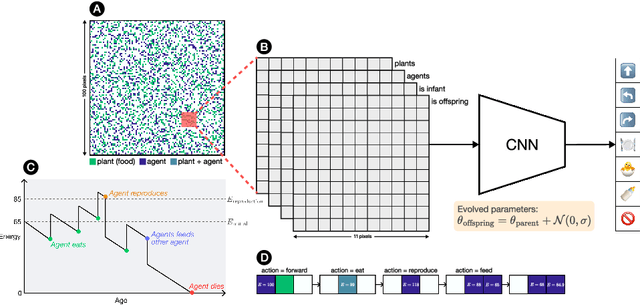

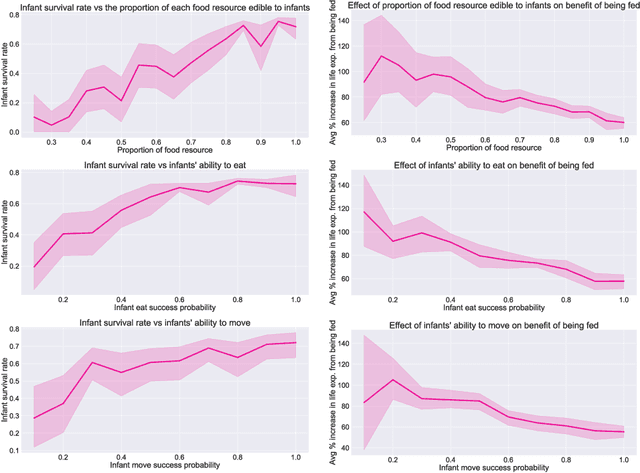
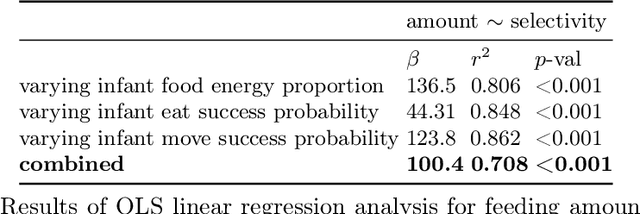
Abstract:Kin selection theory has proven to be a popular and widely accepted account of how altruistic behaviour can evolve under natural selection. Hamilton's rule, first published in 1964, has since been experimentally validated across a range of different species and social behaviours. In contrast to this large body of work in natural populations, however, there has been relatively little study of kin selection \emph{in silico}. In the current work, we offer what is to our knowledge the first demonstration of kin selection emerging naturally within a population of agents undergoing continuous neuroevolution. Specifically, we find that zero-sum transfer of resources from parents to their infant offspring evolves through kin selection in environments where it is hard for offspring to survive alone. In an additional experiment, we show that kin selection in our simulations relies on a combination of kin recognition and population viscosity. We believe that our work may contribute to the understanding of kin selection in minimal evolutionary systems, without explicit notions of genes and fitness maximisation.
Collective Innovation in Groups of Large Language Models
Jul 07, 2024



Abstract:Human culture relies on collective innovation: our ability to continuously explore how existing elements in our environment can be combined to create new ones. Language is hypothesized to play a key role in human culture, driving individual cognitive capacities and shaping communication. Yet the majority of models of collective innovation assign no cognitive capacities or language abilities to agents. Here, we contribute a computational study of collective innovation where agents are Large Language Models (LLMs) that play Little Alchemy 2, a creative video game originally developed for humans that, as we argue, captures useful aspects of innovation landscapes not present in previous test-beds. We, first, study an LLM in isolation and discover that it exhibits both useful skills and crucial limitations. We, then, study groups of LLMs that share information related to their behaviour and focus on the effect of social connectivity on collective performance. In agreement with previous human and computational studies, we observe that groups with dynamic connectivity out-compete fully-connected groups. Our work reveals opportunities and challenges for future studies of collective innovation that are becoming increasingly relevant as Generative Artificial Intelligence algorithms and humans innovate alongside each other.
When LLMs Play the Telephone Game: Cumulative Changes and Attractors in Iterated Cultural Transmissions
Jul 05, 2024



Abstract:As large language models (LLMs) start interacting with each other and generating an increasing amount of text online, it becomes crucial to better understand how information is transformed as it passes from one LLM to the next. While significant research has examined individual LLM behaviors, existing studies have largely overlooked the collective behaviors and information distortions arising from iterated LLM interactions. Small biases, negligible at the single output level, risk being amplified in iterated interactions, potentially leading the content to evolve towards attractor states. In a series of telephone game experiments, we apply a transmission chain design borrowed from the human cultural evolution literature: LLM agents iteratively receive, produce, and transmit texts from the previous to the next agent in the chain. By tracking the evolution of text toxicity, positivity, difficulty, and length across transmission chains, we uncover the existence of biases and attractors, and study their dependence on the initial text, the instructions, language model, and model size. For instance, we find that more open-ended instructions lead to stronger attraction effects compared to more constrained tasks. We also find that different text properties display different sensitivity to attraction effects, with toxicity leading to stronger attractors than length. These findings highlight the importance of accounting for multi-step transmission dynamics and represent a first step towards a more comprehensive understanding of LLM cultural dynamics.
Cultural evolution in populations of Large Language Models
Mar 13, 2024

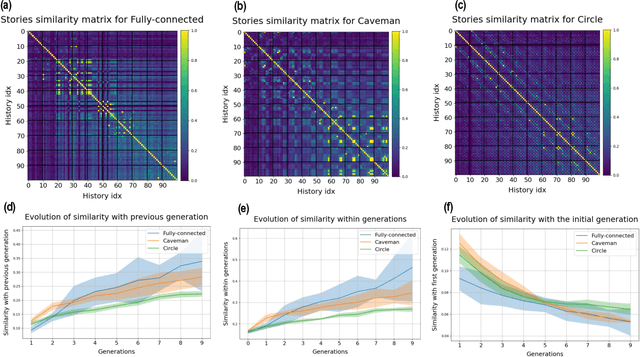

Abstract:Research in cultural evolution aims at providing causal explanations for the change of culture over time. Over the past decades, this field has generated an important body of knowledge, using experimental, historical, and computational methods. While computational models have been very successful at generating testable hypotheses about the effects of several factors, such as population structure or transmission biases, some phenomena have so far been more complex to capture using agent-based and formal models. This is in particular the case for the effect of the transformations of social information induced by evolved cognitive mechanisms. We here propose that leveraging the capacity of Large Language Models (LLMs) to mimic human behavior may be fruitful to address this gap. On top of being an useful approximation of human cultural dynamics, multi-agents models featuring generative agents are also important to study for their own sake. Indeed, as artificial agents are bound to participate more and more to the evolution of culture, it is crucial to better understand the dynamics of machine-generated cultural evolution. We here present a framework for simulating cultural evolution in populations of LLMs, allowing the manipulation of variables known to be important in cultural evolution, such as network structure, personality, and the way social information is aggregated and transformed. The software we developed for conducting these simulations is open-source and features an intuitive user-interface, which we hope will help to build bridges between the fields of cultural evolution and generative artificial intelligence.
Discovering Sensorimotor Agency in Cellular Automata using Diversity Search
Feb 14, 2024
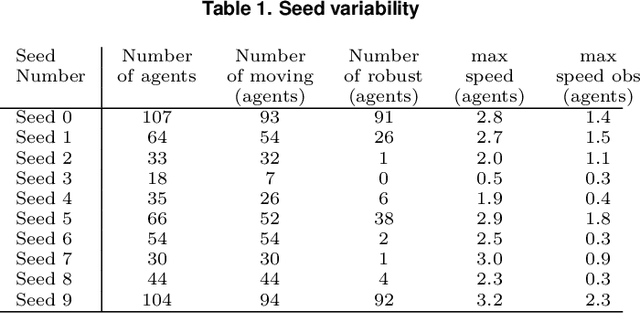
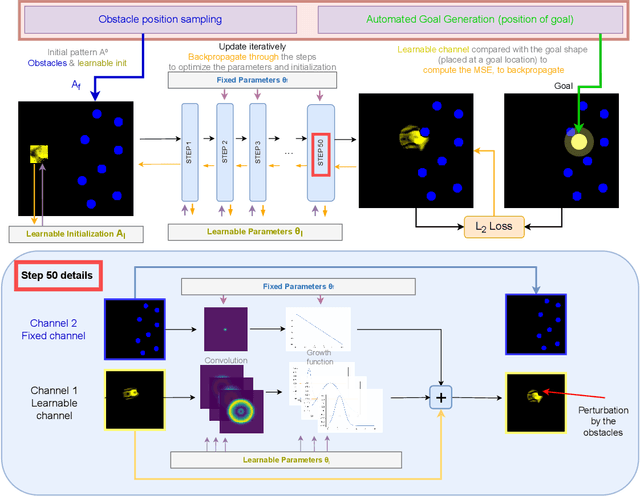
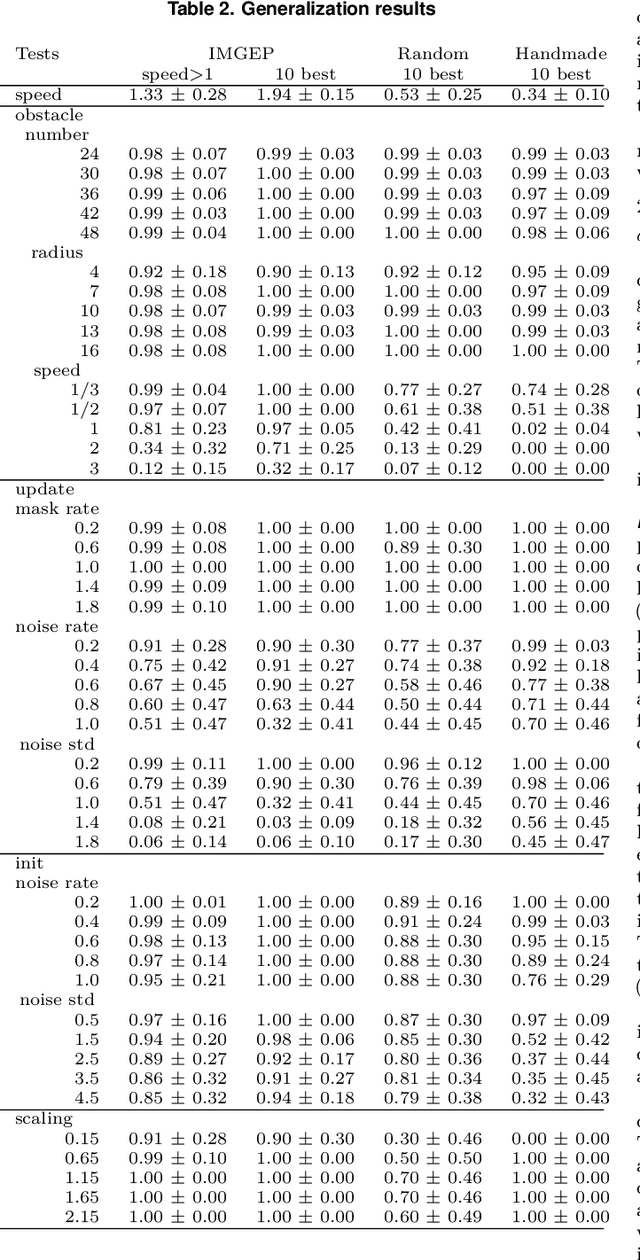
Abstract:The research field of Artificial Life studies how life-like phenomena such as autopoiesis, agency, or self-regulation can self-organize in computer simulations. In cellular automata (CA), a key open-question has been whether it it is possible to find environment rules that self-organize robust "individuals" from an initial state with no prior existence of things like "bodies", "brain", "perception" or "action". In this paper, we leverage recent advances in machine learning, combining algorithms for diversity search, curriculum learning and gradient descent, to automate the search of such "individuals", i.e. localized structures that move around with the ability to react in a coherent manner to external obstacles and maintain their integrity, hence primitive forms of sensorimotor agency. We show that this approach enables to find systematically environmental conditions in CA leading to self-organization of such basic forms of agency. Through multiple experiments, we show that the discovered agents have surprisingly robust capabilities to move, maintain their body integrity and navigate among various obstacles. They also show strong generalization abilities, with robustness to changes of scale, random updates or perturbations from the environment not seen during training. We discuss how this approach opens new perspectives in AI and synthetic bioengineering.
Evolving Reservoirs for Meta Reinforcement Learning
Dec 09, 2023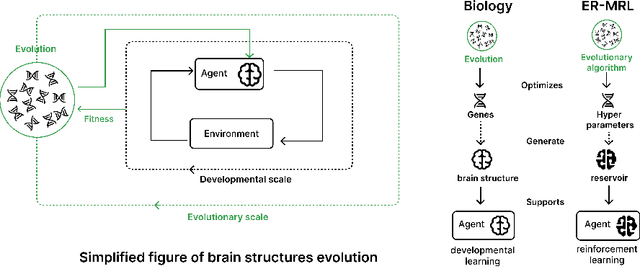
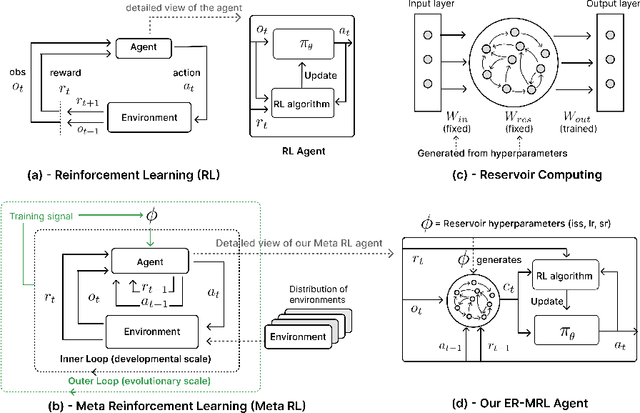
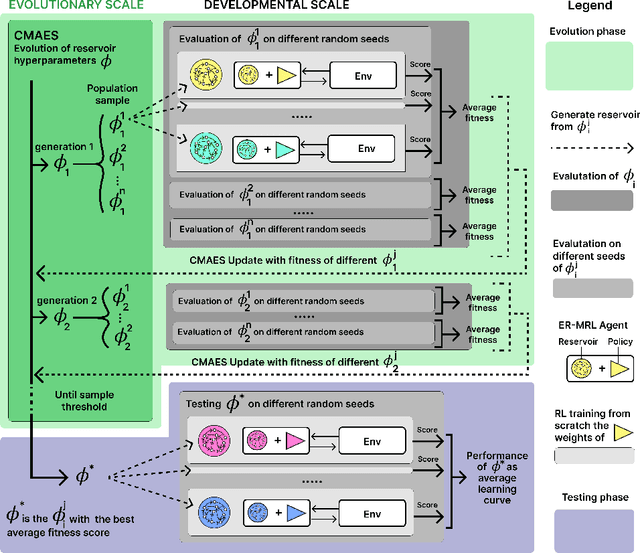
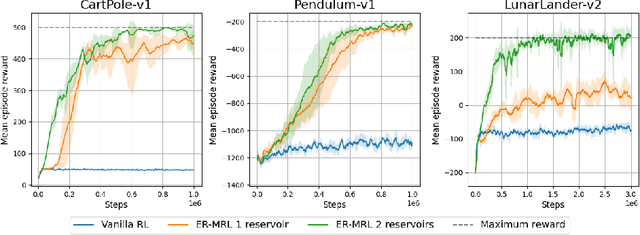
Abstract:Animals often demonstrate a remarkable ability to adapt to their environments during their lifetime. They do so partly due to the evolution of morphological and neural structures. These structures capture features of environments shared between generations to bias and speed up lifetime learning. In this work, we propose a computational model for studying a mechanism that can enable such a process. We adopt a computational framework based on meta reinforcement learning as a model of the interplay between evolution and development. At the evolutionary scale, we evolve reservoirs, a family of recurrent neural networks that differ from conventional networks in that one optimizes not the weight values but hyperparameters of the architecture: the later control macro-level properties, such as memory and dynamics. At the developmental scale, we employ these evolved reservoirs to facilitate the learning of a behavioral policy through Reinforcement Learning (RL). Within an RL agent, a reservoir encodes the environment state before providing it to an action policy. We evaluate our approach on several 2D and 3D simulated environments. Our results show that the evolution of reservoirs can improve the learning of diverse challenging tasks. We study in particular three hypotheses: the use of an architecture combining reservoirs and reinforcement learning could enable (1) solving tasks with partial observability, (2) generating oscillatory dynamics that facilitate the learning of locomotion tasks, and (3) facilitating the generalization of learned behaviors to new tasks unknown during the evolution phase.
 Add to Chrome
Add to Chrome Add to Firefox
Add to Firefox Add to Edge
Add to Edge